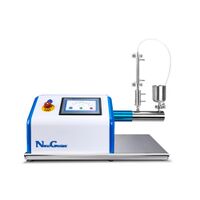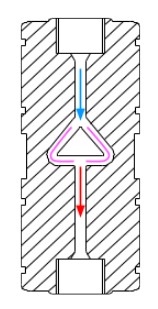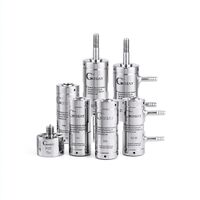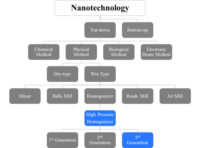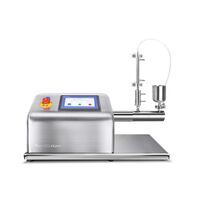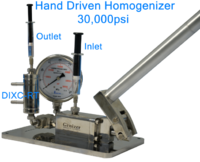Difference between revisions of "High Pressure Homogenizers"
| Line 37: | Line 37: | ||
The motor drives the crankshaft to move the plunger back and forth, directly pressurizing the material. Multiple plungers in the crankshaft work together to produce constant pressure and a high flow rate; large quantities of materials are required to produce the constant pressure. To drive the crankshaft, the motor requires a multi-stage gear reduction mechanism, which makes the equipment large in size. The homogenizer with a crankshaft is suitable for large-scale production with low-pressure applications. | The motor drives the crankshaft to move the plunger back and forth, directly pressurizing the material. Multiple plungers in the crankshaft work together to produce constant pressure and a high flow rate; large quantities of materials are required to produce the constant pressure. To drive the crankshaft, the motor requires a multi-stage gear reduction mechanism, which makes the equipment large in size. The homogenizer with a crankshaft is suitable for large-scale production with low-pressure applications. | ||
====Intensifier type==== | |||
In intensifier-type high pressure homogenizers, the motor drives the intensifier to pressurize the material through the interaction chamber. The intensifier system can provide higher pressure, thereby improving the performance of the homogenization process. The flow rate of the homogenizer with an intensifier is lower than it is for the homogenizer with a crankshaft, smaller amounts of materials are required, and the pressure is higher. It can be used for laboratory applications with small amounts sample, and for production applications with high pressure. When equipped with the diamond interaction chamber, the electric high pressure homogenizer with an intensifier falls into the category of high-end homogenizers. This type is widely used in biology, pharmaceutical, and nanotechnology laboratories. The traditional intensifier is hydraulic, and the new type of electric cylinder by linear actuator is emerged with more performance. | In intensifier-type high pressure homogenizers, the motor drives the intensifier to pressurize the material through the interaction chamber. The intensifier system can provide higher pressure, thereby improving the performance of the homogenization process. The flow rate of the homogenizer with an intensifier is lower than it is for the homogenizer with a crankshaft, smaller amounts of materials are required, and the pressure is higher. It can be used for laboratory applications with small amounts sample, and for production applications with high pressure. When equipped with the diamond interaction chamber, the electric high pressure homogenizer with an intensifier falls into the category of high-end homogenizers. This type is widely used in biology, pharmaceutical, and nanotechnology laboratories. The traditional intensifier is hydraulic, and the new type of electric cylinder by linear actuator is emerged with more performance. | ||
| Line 44: | Line 44: | ||
Hand driven homogenizers pressurize the material by manual power. The flow rate of a hand homogenizer is small, but it is portable and easy to assemble and disassemble. It requires very small amounts of materials, making it suitable for small-scale experiments. This type of device is capable of supporting biopharmaceutical laboratories’ research and development needs. The manual high-pressure homogenizer is also called the Handgenizer.1 | Hand driven homogenizers pressurize the material by manual power. The flow rate of a hand homogenizer is small, but it is portable and easy to assemble and disassemble. It requires very small amounts of materials, making it suitable for small-scale experiments. This type of device is capable of supporting biopharmaceutical laboratories’ research and development needs. The manual high-pressure homogenizer is also called the Handgenizer.1 | ||
====Air Driven==== | |||
The air driven homogenizer converts the pressure of compressed gas into hydraulic pressure. Therefore, it needs the support of a nitrogen cylinder or an air compressor. This homogenizer’s gas consumption and noise levels are high, and its maximum homogenization pressure is generally low. However, since there is no separate intensifier pump structure, its volume is small, and it is suitable for sites equipped with compressed nitrogen. | |||
===By principle and structure of the interaction chamber=== | |||
[[File:High_Pressure_Homogenizers_principle.png|thumb|200px|right|The three-type principle of high pressure homogenization[]] | |||
Revision as of 05:38, 25 February 2022
High Pressure Homogenizers are used for homogenization of compounds that require high pressure for the processes. High Pressure Homogenizers are often the solution particularly useful in the pharmaceutical and biotech industries. High pressure homogenizers, prepare nanomaterial by producing high flow velocity through a small orifice, using a specially designed internal fixed geometry under ultra-high pressure (up to 60,000 psi). During the homogenization process, changes in physical, chemical, structural properties occur, and as a result, homogeneous suspension takes place at nanoscale. The pressure of a conventional homogenizer is within 15,000 psi, while a high pressure homogenizer can achieve 30,000 psi, and an ultra-high pressure homogenizer can reach up to 60,000 psi.
Introduction
High pressure homogenizers are used in the biological, pharmaceutical, food, chemical, and many other industries. Their products and purposes include cell disruption, food homogenization, fine chemicals, preparation of liposomes, fat emulsions, nanosuspensions, microemulsions, lipid microspheres, vaccines, emulsions, dairy products, infusion solutions, dyes, graphene, carbon nanotubes, conductive coatings, nano-oxide dispersion, and more. The global market for high pressure homogenizers is growing annually, and this is especially true in the nanotechnology market. To prepare pharmaceutical nanoemulsions, high pressure homogenizers such as the nanogenizer are essential: Their pressure is always above 20,000 psi, and they feature high-quality diamond interaction chambers to achieve a uniform, pharmaceutical-grade nanoparticle size distribution.
Key Principles
The key component of a high pressure homogenizer includes a homogenization unit such as diamond interaction chamber, and a high pressure pump unit. There is a specially designed fixed geometry inside the diamond interaction chamber. Strokes of the piston in the high pressure pump unit drive the samples through the interaction chamber at supersonic speed. In the chamber, materials are subjected to mechanical forces such as high shearing, high-frequency oscillation, cavitation and convective impact, and corresponding thermal effects simultaneously. These mechanical and physiochemical effects can induce change in the physical, chemical, and particle structure of the materials. This results in uniform and smaller nanoparticle size, achieving a homogenization effect. The interaction chamber is the core of the high pressure homogenizer, and its unique geometric internal structure is the main factor determining the effectiveness of the homogenization process. The intensifier pump exerts the required pressure for materials to pass through the interaction chamber at high speed. The pressure’s strength and stability are important to ensure the production of high-quality nanomaterials.
Applications
The high pressure homogenizer is one of the most effective pieces of equipment for preparing nanomaterial using top-down nanotechnology. The high pressure homogenizer and its interaction chamber have a wide variety of applications in the production of nanomaterial and nanotechnology.
These applications include:
- Preparation of fat emulsion, microemulsions, liposomes, nanosuspensions, and nanoparticles in the pharmaceutical industry;
- Cell disruption, microcapsules, and vaccine adjuvants in biotechnology products;
- Homogenization and emulsification in the food and beverage industry to improve stability, taste, appearance, and encapsulation of nutrients in food products;
- Homogeneous dispersion of products in the cosmetics, fine chemical, and other industries to improve product functionality, increase value, and ensure process stability;
- Dispersion and exfoliation of conductive paste, resistance paste, graphene, carbon nanotubes, and nano-oxides.
Classification
By energy source
Electric
Electric homogenizers are powered by an electric motor. This category of homogenizer can be further subdivided into two types: direct-drive and intensifier.
Direct-drive type
The motor drives the crankshaft to move the plunger back and forth, directly pressurizing the material. Multiple plungers in the crankshaft work together to produce constant pressure and a high flow rate; large quantities of materials are required to produce the constant pressure. To drive the crankshaft, the motor requires a multi-stage gear reduction mechanism, which makes the equipment large in size. The homogenizer with a crankshaft is suitable for large-scale production with low-pressure applications.
Intensifier type
In intensifier-type high pressure homogenizers, the motor drives the intensifier to pressurize the material through the interaction chamber. The intensifier system can provide higher pressure, thereby improving the performance of the homogenization process. The flow rate of the homogenizer with an intensifier is lower than it is for the homogenizer with a crankshaft, smaller amounts of materials are required, and the pressure is higher. It can be used for laboratory applications with small amounts sample, and for production applications with high pressure. When equipped with the diamond interaction chamber, the electric high pressure homogenizer with an intensifier falls into the category of high-end homogenizers. This type is widely used in biology, pharmaceutical, and nanotechnology laboratories. The traditional intensifier is hydraulic, and the new type of electric cylinder by linear actuator is emerged with more performance.
Hand Driven
Hand driven homogenizers pressurize the material by manual power. The flow rate of a hand homogenizer is small, but it is portable and easy to assemble and disassemble. It requires very small amounts of materials, making it suitable for small-scale experiments. This type of device is capable of supporting biopharmaceutical laboratories’ research and development needs. The manual high-pressure homogenizer is also called the Handgenizer.1
Air Driven
The air driven homogenizer converts the pressure of compressed gas into hydraulic pressure. Therefore, it needs the support of a nitrogen cylinder or an air compressor. This homogenizer’s gas consumption and noise levels are high, and its maximum homogenization pressure is generally low. However, since there is no separate intensifier pump structure, its volume is small, and it is suitable for sites equipped with compressed nitrogen.
By principle and structure of the interaction chamber
Processes
Homogenization is a fluid mechanical process that involves the subdivision of particles or droplets into micron sizes to create a stable dispersion or emulsion for further processing.
This is an important stage in the treatment of food and dairy products. It provides improved product stability, shelf life, digestion, and taste. Homogenizing can also significantly reduce the amount of additives required. It prepares feeds so that subsequent spray drying produces the best quality of powders. This is especially important for baby foods and many dairy and food products.
The process occurs in a special homogenizing valve, the design of which is the heart of the homogenizing equipment. The fluid passes through a minute gap in the homogenizing valve. This creates conditions of high turbulence and shear, combined with compression, acceleration, pressure drop, and impact. Causing the disintegration of particles and dispersion throughout the product.
After homogenization, the particles are of a uniform size, typically from 0.2 to 2 micron, depending on the operating pressure. The homogenizer is the most efficient device for particle and droplet size reduction. The actual properties of the product vary with pressure and product type in a complex relationship. In general, higher processing pressure produces smaller particles, down to a certain limit of micronization.
Video

